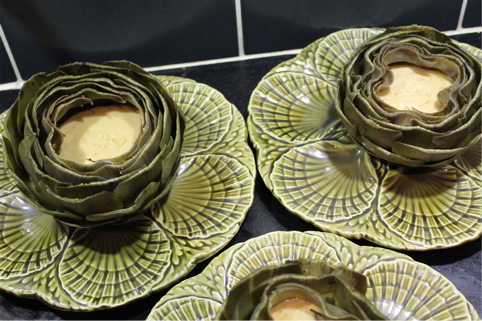My gripe with the Cannes Film Festival is that they never honor my requests to let me view all the films before hand so I know if there are any inspiring food moments in the competing films to help me develop related recipes to post in time for publication during the glittering events. It is really rude of the organizing committee. So, once again this year, I am forced to imagine foods with my only hints being the announced film titles and the posters.
This year’s Cannes poster features a breathtaking view of an ultra-modern building (the future as seen in the quaint past) thrusting from a tree-covered pinnacle slicing into the sea. Quite impressive, but what does it have to do with anything? To me, as a cook, it suggests architectural levels in the realization of a dish: contrasting textures, layers of tastes building one upon another, temperatures, flavors that will spike your palate when you eat. So. There is my faux-theme for Cannes 2016.
Consider the artichoke. It has architectural beauty to please the eye, an element of destruction as you begin to attack it on the plate, and potential for many different guises through careful editing.
It is a perfect entrance to a glamorous dinner in Cannes, regally complementing any designer gown, tuxedo, or vintage jewels your guests may dazzle your visual sense with.
An artichoke can bring the Sexy to your most elegant dinner party, if you bear in mind that this noble entity must be treated like the true star that it is. In the hands of a novice, it can be a tiresome mess; if you follow these steps, your artichoke will be a Salome to tempt you to the table, undressing itself leaf by leaf to reveal its hidden delights.
First: casting. Like any starlet auditioning for a film role, scrutinize your artichoke carefully. Look for a Globe artichoke that is firm and round, bigger than your fist, bigger than a sassy grapefruit. It should have a stem long enough to grip. The tips of the thorny leaves may be split, but they should not be dried, brown, or withered. Give a few leaves a gentle tug. They should not be loose. You want an ingenue for the star of your plates, not an elderly dowager, picked long ago.
Second: rehearsals and make-up. The reason you want a leggy artichoke is that you need that stem for leverage to pull out the stringy fibres that flaw its luscious heart. Don’t just whack the stem off with a knife! Place the artichoke on its side, the stem parallel to your cutting board. Holding the artichoke with one hand, take the palm of your other and apply pressure on the stem near the base of the artichoke. As you press, the stem will start to separate, pulling out the fibers. Rotate the artichoke as you press and the stem should pop off, taking with it all the strings. There are varieties of artichoke without strings, but test to be certain.
The artichoke needs good posture on the plate, so now you can cut off just a sliver of the base – only a sliver! – so it will sit nicely.
With a long serrated knife, now saw through the upper third of the artichoke leaves and discard them.
Set the artichoke flat on its base and use scissors to trim the thorny tips, row by row, starting at the base and moving up. You will have regular rows of pretty, blunted leaves that won’t prick you as you remove them one by one for eating.

Place the artichokes in a large pot of cold water to cover them, with the squeezed juice and carcass of 1 lemon. Base up, or base down – both work in the cooking as long as the artichokes are submerged. Place a clean cotton towel, or several folded white paper towels, on the surface. Artichokes float, so place a slightly smaller pot on top of them to keep them covered with water all through the cooking.
Bring the water to a boil, then simmer the artichokes gently, uncovered, until they are done. Add more water if necessary to keep them submerged. The cooking time will depend very much on the size and type of artichokes, and the point in the season. This can mean as little as 25 minutes, or almost an hour. How do you know when they are done? Simple. A sharp knife will effortlessly penetrate the meat of the base when it is cooked sufficiently, and a leaf near the middle can easily be pulled out.
Lift the subdued artichokes out of the pan, one by one, and shock them in a bowl of cold water. They are a bit fragile at this point, so handle them with care so they don’t break.
After a few minutes, bring them out of the water and place them upside-down on a rack to drain. You don’t want water in your sauce! If you are serving immediately, hold the artichoke base with a kitchen towel, and with another kitchen towel grip the conical ‘choke’ in the center and twist it until it lifts out. If you are lucky, the hairy bits will come out as well. If you are not lucky, gently loosen this inedible part by prying with a spoon. Do not dig into the succulent flesh, the best part!
If you are serving immediately, hop to it! You can also cook them earlier in the day, and heat them up in simmering water and then draining briefly upside down again. Or you can heat them in an oven, or even the microwave.
Third: costuming. Artichokes need to be nicely dressed to achieve the best effect. If your glamorous guests are dieting, make a simple, mustardy vinaigrette speckled with chopped herbs, such as fresh tarragon, chervil, parsley, chives, mint, or coriander. Or go decadent with this wonderful take on classic Hollandaise.
SAUCE HOLLANDAISE AU BEURRE NOISETTE ET AUX CITRONS CONFITS
Makes 1 cup, enough for four to six artichokes
1 cup/250 g unsalted butter
4 egg yolks
4 tablespoons water
salt and pepper to taste
juice of ½ lemon, more to taste
peel and pith of 1 preserved lemon, rinsed and chopped fine
Melt the butter in a pan over medium heat. Cook it until it turns a light brown, it smells like roasting hazelnuts, and you can see brown bits of milk solids on the bottom of the pan. A good sign that it is done is that the bubbling and popping noises it makes during cooking will suddenly stop. This means all the excess water is cooked out. It must be brown, but do not let it turn black and start to smoke! Set the pan aside to cool to tepid, then strain it into a clean small pot or measuring cup.
Whisk the water and egg yolks with salt and pepper in a small, heavy saucepan over low heat and whisk constantly, taking the pan on and off the heat so the mousse does not thicken too quickly. The mousse needs to be thick and billowy like a genoise cake batter, and hold a ribbon trail when the whisk is lifted. This should take 3-5 minutes of whisking on and off the heat source. The mixture must be warm but never hot, or it will curdle. If it starts to get too hot before it is thick, drop in an ice cube and you can save it.
Take the pan from the heat and let it cool for a minute. Whisk in the tepid butter slowly until the sauce emulsifies and thickens a bit. Leave behind the milky whey in the bottom of the pan.
Whisk in the lemon juice and chopped preserved lemon. Return to low heat and whisk until it is quite thick again. Serve immediately on the anxiously awaiting warm artichokes, or keep in a tepid water bath for up to an hour, stirring occasionally. A bit of chopped tarragon, parsley, mint or coriander mixed into the sauce never hurt.
Fourth: performance. Place the artichokes in the centre of a large plate and fill the hollows with the delectable sauce of choice. I like to put the plates on the table before the guests sit down. They will admire.

To savor the glorious artichokes to the fullest, follow this ritual. Starting at the bottom rung, pry loose the artichoke leaves one by one, dipping the fleshy base into the sauce, then scraping the flesh off with your front teeth. Discard the leaves on the plate (that’s why it should be large – or you can place discard bowls for the guests on the table). Work your way rung by one, until at last the delicious, pristine disk of the artichoke base beckons you, naked and fleshy, all alone in the center. Save enough sauce for this treat!
An artichoke is a bit of an effort, but it is a classic to return to again. And again.
Enjoy!

By Randall

